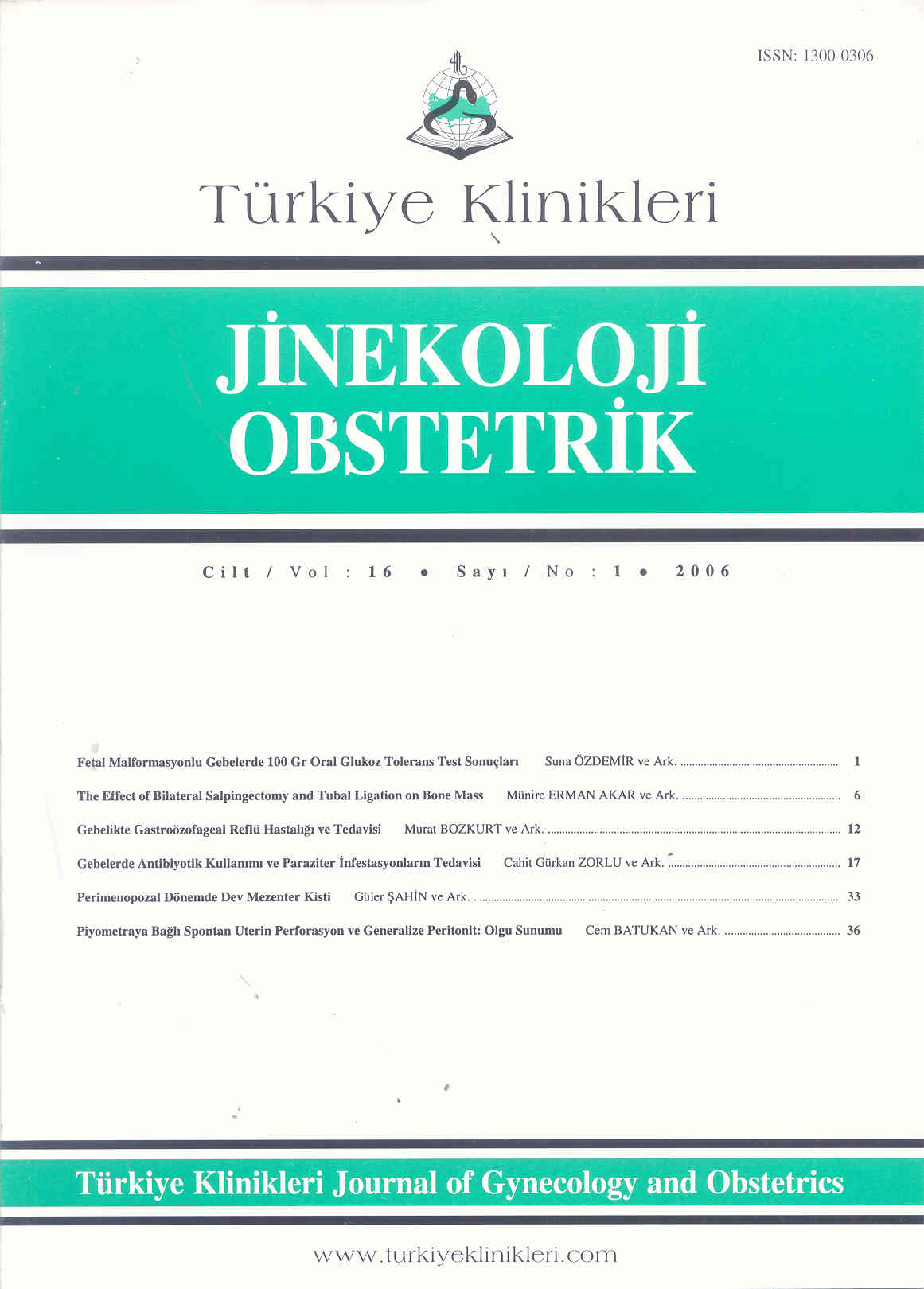Open Access
Peer Reviewed
ORIGINAL RESEARCH
3421 Viewed1086 Downloaded
Results Of Oral 1 Gram Glucose Tolerance Test In Pregnant Women With Fetal Malformations
Fetal Malformasyonlu Gebelerde 1 Gr Oral Glukoz Tolerans Test Sonuçları
Turkiye Klinikleri J Gynecol Obst. 2006;16(1):1-5
Article Language: TR
Copyright Ⓒ 2025 by Türkiye Klinikleri. This is an open access article under the CC BY-NC-ND license (http://creativecommons.org/licenses/by-nc-nd/4.0/)
ÖZET
Amaç: Biz bu çalışmamızda çeşitli fetal malformasyonlarla sonlanmış, daha önce diyabet anamnezi olmayan veya araştırılmamış olan olgularda 100 gr oral glukoz tolerans test ile gestasyonel diabetes mellitus (GDM) sıklığını araştırmayı amaçladık. Gereç ve Yöntemler: Çalışmaya 17-27 gestasyon haftalarında olan, gebelik takipleri sırasında ultrasonografi ile çeşitli sistemlere ait fetal malformasyon saptanmış 50 olgu alındı (grup 1). 100 gr 3 saatlik oral glukoz tolerans test yapıldı. Sonuçlar kontrol grubu ile karşılaştırıldı (grup 2). Verilerin istatistiksel değerlendirilmesinde c2-square test ve Student-t test kullanıldı. Bulgular: GDM grup 1'de 8 olguda (%16), grup 2'de 2 olguda (%4) vardı ve grup 1'de GDM grup 2'ye göre istatistiksel olarak sınırda anlamlıydı (p= 0.046). Grup 1'de daha önceden fetal malformasyonu olan olgularda GDM görülme riski olmayan olgulara göre anlamlı olarak yüksekti (p= 0.012). GDM saptanan olgulardaki fetal malformasyonlar olarak en sık santral sinir sistemi, kistik higroma saptadık. Sonuç: Bulgularımız fetal malformasyonla sonuçlanmış olgularda karbonhidrat metabolizma bozukluğuna eğilimin arttığını göstermektedir. Ek olarak, daha öncesinde fetal malformasyonu olan gebelerde GDM oranının belirgin olarak daha yüksek olması bu grupta ilk antenatal takipte erken GDM araştırılmasının gerekli olduğunu düşünmekteyiz.
Amaç: Biz bu çalışmamızda çeşitli fetal malformasyonlarla sonlanmış, daha önce diyabet anamnezi olmayan veya araştırılmamış olan olgularda 100 gr oral glukoz tolerans test ile gestasyonel diabetes mellitus (GDM) sıklığını araştırmayı amaçladık. Gereç ve Yöntemler: Çalışmaya 17-27 gestasyon haftalarında olan, gebelik takipleri sırasında ultrasonografi ile çeşitli sistemlere ait fetal malformasyon saptanmış 50 olgu alındı (grup 1). 100 gr 3 saatlik oral glukoz tolerans test yapıldı. Sonuçlar kontrol grubu ile karşılaştırıldı (grup 2). Verilerin istatistiksel değerlendirilmesinde c2-square test ve Student-t test kullanıldı. Bulgular: GDM grup 1'de 8 olguda (%16), grup 2'de 2 olguda (%4) vardı ve grup 1'de GDM grup 2'ye göre istatistiksel olarak sınırda anlamlıydı (p= 0.046). Grup 1'de daha önceden fetal malformasyonu olan olgularda GDM görülme riski olmayan olgulara göre anlamlı olarak yüksekti (p= 0.012). GDM saptanan olgulardaki fetal malformasyonlar olarak en sık santral sinir sistemi, kistik higroma saptadık. Sonuç: Bulgularımız fetal malformasyonla sonuçlanmış olgularda karbonhidrat metabolizma bozukluğuna eğilimin arttığını göstermektedir. Ek olarak, daha öncesinde fetal malformasyonu olan gebelerde GDM oranının belirgin olarak daha yüksek olması bu grupta ilk antenatal takipte erken GDM araştırılmasının gerekli olduğunu düşünmekteyiz.
ANAHTAR KELİMELER: Gestasyonel diyabet, fetal malformasyon, oral glukoz tolerans test
ABSTRACT
Objective: The aim of this study is to determine the frequency of gestational diabetes mellitus (GDM) in pregnant women with fetal malformations and without previous history of diabetes mellitus or GDM by 100 gr oral glucose tolerance test. Material and Methods: In this study, 50 pregnant women with fetal malformations that were detected by ultrasonography during antenatal follow-up (group I) were enrolled. Gestational weeks of these pregnancies were between 17-27 weeks. 100 gr oral glucose tolerance test was performed. The findings were compared with control groups (group 2). Chi-square and student-t test were used for statistical analysis. Results: GDM was detected in 8 cases (16%) of group 1 and in 2 cases (4%) of group 2. There was statistically increased risk of GDM in group I (p= 0.046). In group I, the cases with history of previous fetal malformation had significantly increased risk of GDM when compared with no history of previous malformations (p= 0.012). Cental nervous system malformations and cystic hygroma were detected as the most common fetal malformations in the cases with GDM. Conclusion: Our findings showed increased tendency of deterioration of carbonhydrathe metabolism in the pregnant women with fetal malformations. In addition, due to increased rate of GDM in the women with previous history of fetal malformation, we suggested that early glucose intolerance tests (100 gr OGTT) should be performed in these cases during first antenatal visit.
Objective: The aim of this study is to determine the frequency of gestational diabetes mellitus (GDM) in pregnant women with fetal malformations and without previous history of diabetes mellitus or GDM by 100 gr oral glucose tolerance test. Material and Methods: In this study, 50 pregnant women with fetal malformations that were detected by ultrasonography during antenatal follow-up (group I) were enrolled. Gestational weeks of these pregnancies were between 17-27 weeks. 100 gr oral glucose tolerance test was performed. The findings were compared with control groups (group 2). Chi-square and student-t test were used for statistical analysis. Results: GDM was detected in 8 cases (16%) of group 1 and in 2 cases (4%) of group 2. There was statistically increased risk of GDM in group I (p= 0.046). In group I, the cases with history of previous fetal malformation had significantly increased risk of GDM when compared with no history of previous malformations (p= 0.012). Cental nervous system malformations and cystic hygroma were detected as the most common fetal malformations in the cases with GDM. Conclusion: Our findings showed increased tendency of deterioration of carbonhydrathe metabolism in the pregnant women with fetal malformations. In addition, due to increased rate of GDM in the women with previous history of fetal malformation, we suggested that early glucose intolerance tests (100 gr OGTT) should be performed in these cases during first antenatal visit.
MENU
POPULAR ARTICLES
MOST DOWNLOADED ARTICLES





This journal is licensed under a Creative Commons Attribution-NonCommercial-NoDerivatives 4.0 International License.










